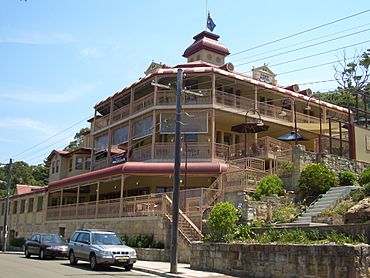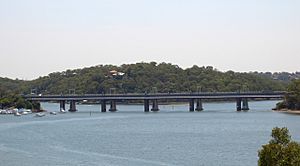Como, New South Wales facts for kids
Quick facts for kids ComoSydney, New South Wales |
|||||||||||||||
|---|---|---|---|---|---|---|---|---|---|---|---|---|---|---|---|

Como Hotel
|
|||||||||||||||
| Population | 3,977 (2016 census) | ||||||||||||||
| Established | 1883 | ||||||||||||||
| Postcode(s) | 2226 | ||||||||||||||
| Elevation | 31 m (102 ft) | ||||||||||||||
| Location | 27 km (17 mi) south of Sydney CBD | ||||||||||||||
| LGA(s) | Sutherland Shire | ||||||||||||||
| State electorate(s) | Miranda | ||||||||||||||
| Federal Division(s) | Hughes | ||||||||||||||
|
|||||||||||||||
Como is a suburb in southern Sydney, New South Wales, Australia. It sits on the southern banks of the Georges River, about 27 kilometres south of the Sydney central business district. Como is part of the Sutherland Shire local government area. Its postcode is 2226, which it shares with nearby suburbs like Jannali and Bonnet Bay. The area called Como West, which is part of Como, was created in 1939. Como's shoreline has beautiful spots like Bonnet Bay and Scylla Bay.
Contents
Exploring Como's Past
The land where Como is today was originally the traditional home of the Tharawal (Dharawal) people. The Sutherland Shire Council officially recognises them as the first custodians of this land.
Before it was called Como, this area was known as Woronora. In 1883, a small hotel called the Woronora Hotel was built here. It served the railway workers who were extending the Illawarra railway line and building a bridge over the Georges River. A post office, also called Woronora Post Office, opened nearby in the same year.
In 1922, the name of the area changed from Woronora to Como. This idea came from Mr. James Frederick Murphy, who managed the land owned by Thomas Holt. Mr. Murphy thought the area looked like Lake Como in Italy, which is famous for its beautiful scenery near mountains. This Italian influence can still be seen in many street names in Como, like Genoa Street, Verona Range, and Tivoli Esplanade, all named after cities in Italy.
The first school in the area, originally called Worinora Public School, opened in 1884. Shortly after, its name was changed to Como Public School. Over time, the area became known as "Lake Como" in some newspapers because of the beautiful river views.
The Como Pleasure Grounds, a popular public park today, was once a private area called Murphy's Pleasure Grounds. James Murphy and his brothers managed it, even charging a small fee for visitors to enjoy the views from a lookout point. Later, this area became a public park for everyone to enjoy.
The Como Hotel has a long history. The first version was built around 1887. A much larger, grander version was built in 1890. This hotel was even visited by the famous Australian poet Henry Lawson in the early 1900s! Local stories say he would row his boat to the hotel and share his poems for a drink. Sadly, the second Como Hotel was destroyed by a fire in 1996. A new, similar-looking hotel was built in its place in 2001.
In 1939, Como West got its own post office and a new school, Como West Public School. In 1994, a big bushfire sadly destroyed many houses in Como West, including the school. A new school was then built on the same spot.
Boats and the River
Como has a history of boat building and boat hire. In the early 1880s, the Murphy brothers opened the first commercial boathouse here. Como became known for building strong boats. In 1885, a large steamer ship called the "Active" was successfully launched at Como. It was built to carry railway materials.
Over the years, several boat hire businesses operated in Como, letting people enjoy the Georges River. By 1899, as more people moved to Sydney's south, there was a big demand for riverboat tours. A large paddle steamer, the S.S. "Telephone", even started offering tours from Como, carrying up to 200 passengers.
Railways and Bridges
Georges River Railway Bridge and Como Station
The Illawarra railway line was extended to Como in the 1880s. The first railway bridge over the Georges River, known as the Como railway bridge, opened in 1885. A single-platform railway station also opened at Como.
When the railway bridge opened in 1886, Como became a very popular spot for weekend trips from Sydney. People loved coming here for river cruises and holidays. The trains were often very crowded!
Because so many people were using the line, the small station was upgraded in 1891 with two platforms.
After 1942, the original Georges River rail bridge was used to carry a water pipeline. In 1972, a new concrete railway bridge was built next to the old one, allowing for more trains. A new Como railway station was also built further south, and the old station was taken down. The original Como Railway Bridge is now a path for people walking and cycling.
Places to Stay and Visit
The first hotel in the area was the Woronora Hotel, which opened around 1883. Later, the larger Como Hotel was built.
The Como Hotel
There have been three main versions of the Como Hotel. The first was a smaller building, completed around 1887. The second, much grander version, was finished in 1890. This is the one that Henry Lawson supposedly visited. It was a beautiful, multi-story building.
Sadly, this second hotel was destroyed by a fire in November 1996. But a new, third version was built on the same spot and opened in 2001. It looks similar to the old one but with modern touches. Its restaurant is even called "The Burnt Door," and it has a charred door from the fire as a reminder!
You might see "1878" on the current Como Hotel building, but historical records show the first Como Hotel was actually completed in 1887, and the grand second version in 1890. So, 1890 is the more accurate establishment date for the main hotel building.
Getting Around Como
Como railway station is on the Eastern Suburbs & Illawarra Line of the Sydney Trains network. It's the first station you reach after crossing the Georges River from Oatley. A train trip from Como to Sydney Central takes about 35 minutes.
There has never been a road bridge built across the Georges River at Como.
Famous Spots in Como
The Como Hotel is a well-known landmark. You can enjoy watching local rugby league games from its balconies and eat at "The Burnt Door" restaurant.
Other important places include the Como School of Arts, Cafe de Como, and the Como Marina on the Georges River.
For families and picnickers, the Como Pleasure Grounds offer plenty of space, lawns, seating, and play areas. It's also home to the Como Swimming Club, with swimming baths and a freshwater pool. If you're adventurous, you might even find Sydney rock oysters along the muddy foreshore at low tide!
Schools in Como
Como has two well-regarded public schools: Como Public School and Como West Public School.
Como Public School
The first school in the area was called Worinora School and opened in 1884. It was soon renamed Como Public School. This first school closed in 1885 as many railway workers and their families moved away.
A new (and current) Como Public School was built and opened in 1921 at the corner of Cremona and Genoa Streets. It quickly became popular and needed additions by 1922 due to the growing population.
Como West Public School
The original Como West Public School was built in 1939. Sadly, this school was completely destroyed by the big bushfires that swept through Como West in 1994. A new Como West Public School was then rebuilt on the same site in 1994.
Sports and Fun
Como is a great place for sports and recreation. It's home to the St. George Rowing Club, where many talented rowers start their careers.
You'll also find several parks, including Scylla Bay Oval, which is the home ground for the Como-Jannali Crocodiles rugby league team. The historic Como Pleasure Grounds are perfect for swimming and relaxing.
In Como West, there's a lovely public park called the Henry Lawson Memorial Reserve. It's very popular with local families and has a modern playground. Locals often call it "the blue fence park," though it's now "the black fenced park" after recent renovations!
Como's Population Growth
Como's population has changed a lot over time:
- In May 1883, there were about 120 people, mostly railway workers.
- By November 1884, the population grew to around 500 or 600 people due to the railway work.
- However, the population dropped significantly after 1885 as railway workers moved on.
- For many years, Como's permanent population remained quite small. In 1952, it was only about 680 people.
- Since then, Como has grown steadily.
- The 2001 Australian Census recorded 3,673 people.
- By the 2016 Australian Census, the population had reached 3,977 people.
Who Lives in Como?
According to the 2011 census, Como had 3,789 residents. The most common backgrounds were English (30.8%), Australian (30.7%), and Irish (10.3%).
Most homes in Como (93.9%) are separate houses, which is much higher than the national average. Also, many people in Como own their homes, with only 9.8% of private homes being rented.
Images for kids




